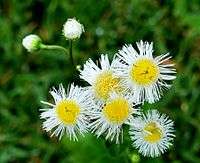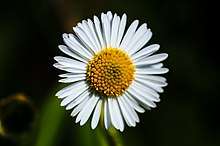Erigeron annuus
Erigeron annuus (annual fleabane, daisy fleabane,[3] or eastern daisy fleabane[4]) is a North American plant species in the daisy family.
| Annual fleabane | |
|---|---|
.jpg) | |
| Flowers and buds | |
| Scientific classification | |
| Kingdom: | |
| (unranked): | |
| (unranked): | |
| (unranked): | |
| Order: | |
| Family: | |
| Tribe: | |
| Genus: | |
| Species: | E. annuus |
| Binomial name | |
| Erigeron annuus | |
| Synonyms[1][2] | |
| |
Description and identification



Erigeron annuus is a herbaceous plant with alternate, simple leaves, and green, sparsely hairy stems, which can grow to between 30 and 150 centimeters (about 1 to 5 feet) in height. Leaves are numerous and large relative to other species of Erigeron, with lower leaves, especially basal leaves, coarsely toothed or cleft, a characteristic readily distinguishing this species from most other Erigeron.[3][4] Upper leaves are sometimes (not always) toothed, but may have a few coarse teeth towards the outer tips.[5][6]
The flower heads are white with yellow centers, with rays that are white to pale lavender, borne spring through fall depending on the individual plant.[7] Ray florets number 40 to 100.[3]
Range
Erigeron annuus is native to North America, and is found in 43 of the 48 states within the contiguous United States. It is widespread in many of them, especially in the eastern part of its range, but occurs only in scattered locations in the western and southernmost parts of its range.[8] It has been introduced to many other places,[9][10][11] including Korea.[12]
Ecology and life cycle
It often grows as an annual but can sometimes grow as a biennial.
Erigeron annuus is a native pioneer species that often colonizes disturbed areas such as pastures, abandoned fields, vacant lots, roadsides, railways, and waste areas. In these habitats it competes, often successfully, with introduced invasive weeds.[5]
Habitat preferences
Erigeron annuus grows well in full through partial sun, on sites with ample moisture. It is tolerant of a wide range of soil conditions, including gravel and clay. In hot, dry weather, lower leaves often yellow and wither.[5]
Faunal associations
Flowers are pollinated by a variety of bees, including little carpenter bees, cuckoo bees, halictine bees, and masked bees; as well as flies, including syrphid flies, bee flies, tachinid flies, flesh flies, anthomyiid flies, and muscid flies. Wasps, small butterflies, and other insects also visit the flowers to a lesser degree, seeking nectar, as well as a few pollen-feeding beetles.[5]
Schinia lynx (lynx flower moth) caterpillars feed on the flowers and seeds of annual fleabane and other fleabanes, and Lygus lineolaris (tarnished plant bug) sucks the plant juices. Some mammals eat the foliage, flowers and stems, including sheep, groundhogs, and rabbits.[5]
References
- "Erigeron annuus", Tropicos, Missouri Botanical Garden
- "Erigeron annuus subsp. septentrionalis", The Global Compositae Checklist (GCC) – via The Plant List
- Ann Fowler Rhoads and Timothy A. Block, Ill. Ann Anisko, Plants of Pennsylvania, 2nd ed, University of Pennsylvania Press, 2007. pp. 923.
- David M. Brandenburg, Field Guide to Wildflowers of North America, National Wildlife Federation, Sterling Publishing Co., New York, 2010, pp. 150.
- Hilty, John (2016), "Annual Fleabane (Erigeron annuus)", Illinois Wildflowers
- Nesom, Guy L. (2006), "Erigeron annuus", in Flora of North America Editorial Committee (ed.), Flora of North America North of Mexico (FNA), 20, New York and Oxford – via eFloras.org, Missouri Botanical Garden, St. Louis, MO & Harvard University Herbaria, Cambridge, MA
- "Annual Fleabane", USGS, 3 August 2006, retrieved 29 April 2008
- Biota of North America Program 2014 state-level distribution map
- "Erigeron annuus", Natural Resources Conservation Service PLANTS Database. USDA
- Chen, Yilin; Brouillet, Luc, "Erigeron annuus", Flora of China – via eFloras.org, Missouri Botanical Garden, St. Louis, MO & Harvard University Herbaria, Cambridge, MA
- Altervista Flora Italiana, Cespica annua, Erigeron annuus (L.) Desf. includes photos and European distribution map
- "개망초". www.doopedia.co.kr (in Korean). Retrieved 2018-05-07.
External links
- Erigeron annuus in the CalPhotos Photo Database, University of California, Berkeley
| Wikimedia Commons has media related to Erigeron annuus. |
| Wikispecies has information related to Erigeron annuus |
| Wikiversity has bloom time data for Erigeron annuus on the Bloom Clock |